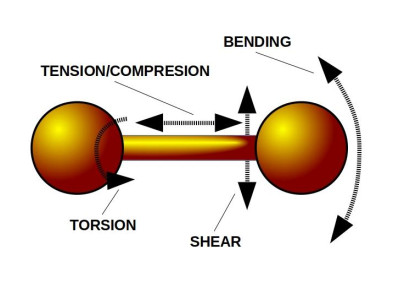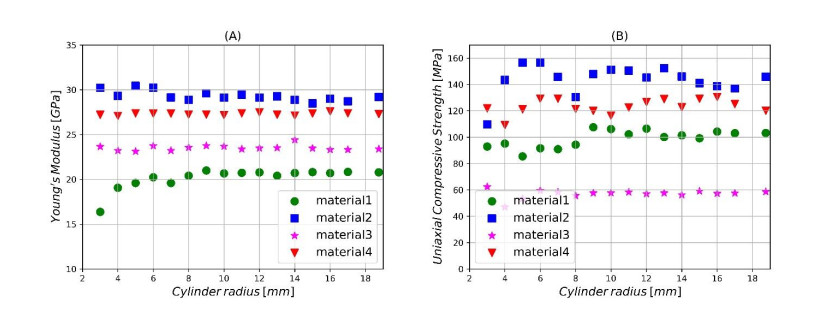|
[1]
|
H. Q. Do, A. M. Aragon, D. L. Schott, Automated discrete element method calibration using genetic and optimization algorithms, EPJ Web of Conferences, 140 (2017), 15011. doi: 10.1051/epjconf/201714015011

|
|
[2]
|
L. Benvenuti, C. H. Kloss, S. Pirker, Characterization of DEM particles by means of artificial neural networks and macroscopic experiments, 16th EANN workshops, 2015.
|
|
[3]
|
E. Onate, J. Rojek, Combination of discrete element and finite element methods for dynamic analysis of geomechanics problems, Computer Meth. Appl. Mech. Eng., 193 (2004), 3087-3128. doi: 10.1016/j.cma.2003.12.056

|
|
[4]
|
B. Yang, Y. Jiao, S. Lei, A study on the effects of microparameters on macroproperties for specimens created by bonded particles, Eng. Comput., 23 (2006), 607-631. doi: 10.1108/02644400610680333

|
|
[5]
|
A. Fakhimi, T. Villegas, Application of dimensional analysis in calibration of a discrete element model for rock deformation and fracture, Rock. Mech. Rock. Eng., 40 (2007), 193-211. doi: 10.1007/s00603-006-0095-6

|
|
[6]
|
Y. Wang, F. Tonon, Calibration of a discrete element model for intact rock up to its peak strength, Int. J. Numer. Anal. Met., 34 (2010), 447-469. doi: 10.1002/nag.811

|
|
[7]
|
H. Q. Do, A. M. Aragón, D. L. Schott, A calibration framework for discrete element model parameters using genetic algorithms, Adv. Powder. Technol., 29 (2018), 1393-1403. doi: 10.1016/j.apt.2018.03.001

|
|
[8]
|
M. Wang, P. Cao, Calibrating the micromechanical parameters of the PFC2D (3D) models using the improved simulated annealing algorithm, Math. Probl. Eng., 1 (2017), 1-11.
|
|
[9]
|
L. Benvenuti, C. Kloss, S. Pirker, Identification of DEM simulation parameters by artificial neural networks and bulk experiments, Powder Technol., 291 (2016), 456-465. doi: 10.1016/j.powtec.2016.01.003

|
|
[10]
|
M. J. Sun, H. M. Tang, X. L. Hu, Y. F. Ge, S. Lu, Microparameter prediction for a triaxial compression PFC3D model of rock using full factorial designs and artificial neural networks, Geotech. Geol. Eng., 31 (2013), 1249-1259. doi: 10.1007/s10706-013-9647-1

|
|
[11]
|
A. S. Tawadrous, D. De Gagné, M. Pierce, D. Mas Ivars, Prediction of uniaxial compression PFC3D model micro-properties using artificial neural networks, Int. J. Numer. Anal. Met., 33 (2009), 1953-1962.
|
|
[12]
|
M. Chunhui, J. Yang, G. Zenz, E. J. Staudacher, L. Cheng, Calibration of the microparameters of the discrete element method using a relevance vector machine and its application to rockfill materials, Adv. Eng. Software, 147 (2020), 102833. doi: 10.1016/j.advengsoft.2020.102833

|
|
[13]
|
C. O'Sullivan, J. D. Bray, Selecting a suitable time step for discrete element simulations that use the central difference time integration scheme, Eng. Comput., 21 (2004), 2-4,278-303.
|
|
[14]
|
S. Abe, V. Boros, W. Hancock, D. Weatherley, ESyS-particle tutorial and user's guide, Version 2.3.1, https://launchpad.net/esys-particle, 2014.
|
|
[15]
|
D. K. Weatherley, V. E. Boros, W. R. Hancock, S. Abe, Scaling benchmark of ESyS-Particle for elastic wave propagation simulations, 2010 IEEE Sixth Int. Conf. e-Science, Brisbane, Australia, 277-283, 2010.
|
|
[16]
|
Y. C. Wang, S. Xue, J. Xie, Discrete element method and its applications in earthquake and rock fracture modelling, In Y.-G. Li (ed.) Imaging, Modeling and Assimilation in Seismology, De Gruyter, 235-262, 2012
|
|
[17]
|
P. A. Cundall, A computer model for simulating progressive, large-scale movement in blocky rock systems, Proc. Symp. Int. Soc. Rock Mech., 2 (1971), 8.
|
|
[18]
|
P. A. Cundall, A computer model for rock-mass behavior using interactive graphics for the input and output of geometrical data, National Technical Information Service, Report no. AD/A-001 602, 1974.
|
|
[19]
|
P. A. Cundall, O. D. L. Strack, A discrete numerical model for granular assemblies, Geotechnique, 29 (1979), 47-65. doi: 10.1680/geot.1979.29.1.47

|
|
[20]
|
D. O. Potyondy, P. A. Cundall, A bonded-particle model for rock, Int. J. Rock Mech. Min. Sci., 41 (2004), 1329-1364. doi: 10.1016/j.ijrmms.2004.09.011

|
|
[21]
|
Y. Wang, S. Abe, S. Latham, P. Mora, Implementation of particle-scale rotation in the 3-D lattice solid model, Pure Appl. Geophys., 163 (2000), 1769-1785.
|
|
[22]
|
Y. C. Wang, A new algorithm to model the dynamics of 3-D bonded rigid bodies with rotations, Acta Geotech., 4 (2009), 117-127. doi: 10.1007/s11440-008-0072-1

|
|
[23]
|
T. L. Anderson, Fracture Mechanics: Fundamentals and Applications, CRC Press, Boca Raton, 1991.
|
|
[24]
|
R. M. Christensen, The theory of materials failure, Oxford University Press, Oxford, 2013.
|
|
[25]
|
A. Geron, Hands-On Machine Learning with Scikit-Learn and TensorFlow, O'Reilly Media, Inc, USA, 2017.
|
|
[26]
|
S. Makridakis, S. C. Wheelwright, R. J. Hyndman, Forecasting methods and applications, John Wiley & Sons, Hoboken, NJ, USA, 2008.
|
|
[27]
|
L. Breiman, Random forests, Mach. Learn., 45 (2001), 5-32.
|
|
[28]
|
P. Mora, D. Place, Stress correlation function evolution in lattice solid elasto-dynamic models of shear and fracture zones and earthquake prediction, Pure Appl. Geophys., 159 (2002), 2413-2427. doi: 10.1007/s00024-002-8741-8

|
|
[29]
|
P. Klejment, The microscopic insight into fracturing of brittle materials with the discrete element method, Publications of the Institute of Geophysics Polish Academy of Sciences—Geophysical Data Bases, Processing and Instrumentation, 427 (A-31), 2020.
|
|
[30]
|
Y.G. Li, ed., Imaging, Modeling and Assimilation in Seismology, De Gruyter, Berlin, 2012.
|









 DownLoad:
DownLoad:












